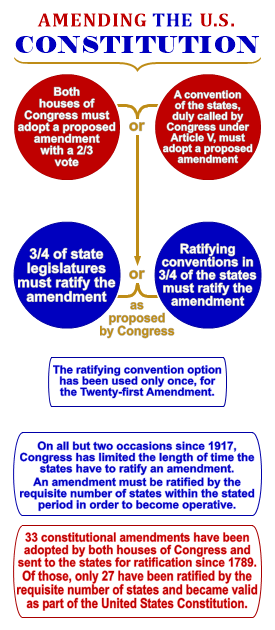Article Five of the United States Constitution



Article Five of the United States Constitution outlines the process for amending the United States Constitution. It is a crucial mechanism within the document, allowing for its evolution over time to address new issues and societal changes while maintaining the foundational principles of the nation. This adaptability is a key feature of the Constitution, ensuring its relevance and functionality across centuries.
Overview[edit]
Article Five provides two methods for proposing amendments to the Constitution and two methods for ratification. Amendments can be proposed either by the Congress with a two-thirds majority vote in both the House of Representatives and the Senate or by a convention called for by two-thirds of the State legislatures. Once proposed, the amendment must be ratified by either the legislatures of three-fourths of the states or by conventions held in three-fourths of the states, as determined by Congress. The choice of method has historically been the former, with the ratification by state legislatures.
Historical Context[edit]
The inclusion of Article Five was a response to the recognition by the Founding Fathers of the need for a structured method of amending the Constitution to adapt to unforeseen future circumstances without resorting to revolution or illegal means. This foresight has allowed the Constitution to be amended 27 times since its ratification in 1788, addressing critical issues such as the abolition of slavery (Thirteenth Amendment), the extension of voting rights (Fifteenth Amendment, Nineteenth Amendment, Twenty-fourth Amendment, and Twenty-sixth Amendment), and changes to the electoral process (Twelfth Amendment, Twenty-second Amendment).
Procedure[edit]
The process outlined in Article Five is intentionally rigorous, requiring broad consensus across different branches of government and the states to make changes. This high threshold helps ensure that amendments reflect widespread agreement and are not made hastily or in response to temporary political pressures.
Proposal[edit]
- Congressional Proposal: This is the most common method. An amendment is proposed by a two-thirds majority vote in both the House of Representatives and the Senate.
- Convention for Proposing Amendments: This method has never been used. It involves a convention called by Congress in response to requests from two-thirds of the state legislatures.
Ratification[edit]
- By State Legislatures: This is the most common method of ratification, used for all but one amendment. It requires approval by three-fourths of the state legislatures.
- By Conventions in States: This method has been used only once, to ratify the Twenty-first Amendment, which repealed Prohibition.
Limitations[edit]
Article Five also specifies that no amendment can deprive a state of its equal representation in the Senate without its consent. This provision ensures the protection of the states' equal standing in the federal system, highlighting the importance of federalism in the structure of the United States government.
Significance[edit]
Article Five has played a critical role in the evolution of the United States, allowing for peaceful and legal changes to the Constitution that reflect the changing values and needs of the nation. It embodies the principles of democracy and federalism, ensuring that the Constitution remains a living document, adaptable yet stable.
Ad. Transform your life with W8MD's Budget GLP-1 injections from $75


W8MD offers a medical weight loss program to lose weight in Philadelphia. Our physician-supervised medical weight loss provides:
- Weight loss injections in NYC (generic and brand names):
- Zepbound / Mounjaro, Wegovy / Ozempic, Saxenda
- Most insurances accepted or discounted self-pay rates. We will obtain insurance prior authorizations if needed.
- Generic GLP1 weight loss injections from $75 for the starting dose.
- Also offer prescription weight loss medications including Phentermine, Qsymia, Diethylpropion, Contrave etc.
NYC weight loss doctor appointmentsNYC weight loss doctor appointments
Start your NYC weight loss journey today at our NYC medical weight loss and Philadelphia medical weight loss clinics.
- Call 718-946-5500 to lose weight in NYC or for medical weight loss in Philadelphia 215-676-2334.
- Tags:NYC medical weight loss, Philadelphia lose weight Zepbound NYC, Budget GLP1 weight loss injections, Wegovy Philadelphia, Wegovy NYC, Philadelphia medical weight loss, Brookly weight loss and Wegovy NYC
|
WikiMD's Wellness Encyclopedia |
| Let Food Be Thy Medicine Medicine Thy Food - Hippocrates |
Medical Disclaimer: WikiMD is not a substitute for professional medical advice. The information on WikiMD is provided as an information resource only, may be incorrect, outdated or misleading, and is not to be used or relied on for any diagnostic or treatment purposes. Please consult your health care provider before making any healthcare decisions or for guidance about a specific medical condition. WikiMD expressly disclaims responsibility, and shall have no liability, for any damages, loss, injury, or liability whatsoever suffered as a result of your reliance on the information contained in this site. By visiting this site you agree to the foregoing terms and conditions, which may from time to time be changed or supplemented by WikiMD. If you do not agree to the foregoing terms and conditions, you should not enter or use this site. See full disclaimer.
Credits:Most images are courtesy of Wikimedia commons, and templates, categories Wikipedia, licensed under CC BY SA or similar.
Translate this page: - East Asian
中文,
日本,
한국어,
South Asian
हिन्दी,
தமிழ்,
తెలుగు,
Urdu,
ಕನ್ನಡ,
Southeast Asian
Indonesian,
Vietnamese,
Thai,
မြန်မာဘာသာ,
বাংলা
European
español,
Deutsch,
français,
Greek,
português do Brasil,
polski,
română,
русский,
Nederlands,
norsk,
svenska,
suomi,
Italian
Middle Eastern & African
عربى,
Turkish,
Persian,
Hebrew,
Afrikaans,
isiZulu,
Kiswahili,
Other
Bulgarian,
Hungarian,
Czech,
Swedish,
മലയാളം,
मराठी,
ਪੰਜਾਬੀ,
ગુજરાતી,
Portuguese,
Ukrainian
